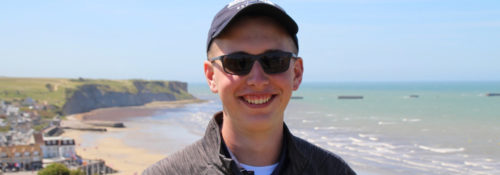
“This was a Sacred, Solemn Place”
The summer before my freshman year at Hillsdale, I was a student in the College’s Winston Churchill and World War II High School Summer Study and Travel Course. I saw it as an opportunity to discover what Hillsdale was all about before the demands of my freshman year began. The trip did not disappoint. I was surrounded by fellow students who were as excited as I was to be there and eager to see firsthand the places we had been studying in our preparation for the course and the campus lectures leading up to our journey across the Atlantic. As the title of the program suggests, the focus of our learning was the great British prime minister and the Second World War, with a special emphasis on D-Day and the invasion of Normandy. All the sites we visited on our course itinerary were amazing, but it was our time in Normandy—at the museums, beaches, and cemeteries—that I cherish most. Visiting during the summer of the 75th anniversary of the D-Day invasion made it even more special.
Following a day of classes in Hillsdale and time around London and Oxford in England, we boarded a ferry in Portsmouth that would take us on our overnight voyage across the British Channel. We ate dinner on board and watched the sunset from the top deck. Soon after waking up the next day, we arrived at the French coast in the early hours of the morning. I couldn’t help but think about the soldiers who had made the same journey seventy-five years before us under strikingly different circumstances. I had traveled across the channel in a luxurious ferry with restaurants, gifts shops, and comedy clubs, while they were packed like sardines into cramped naval vessels and open-air landing craft. When they came ashore, they were greeted by horrifying gunfire, explosions, and chaos. When I came ashore, all I had before me was a customs agent checking my passport.
For me, the most meaningful moments of the trip came during our visit to the American Cemetery at Normandy. A small group of us began by finding the grave of a Hillsdale College student, Frank Moran, who had given his life at the age of twenty-two during the invasion. I then broke off from the group and wandered around the cemetery in solitude. As I walked among row upon row of white crosses, I was filled with grief, contemplating the lives and stories of the men buried beneath me. It was especially moving realizing I was the same age as many of the soldiers who had selflessly risked their lives for the liberation of Europe.
After some time in the cemetery, we made our way down the trail to Omaha Beach. I was surprised to see people swimming, women sunbathing, and children playing in the sand. “This was a sacred, solemn place,” I thought to myself. How could this be allowed? But I quickly remembered the wise words that Dr. Tom Conner, our instructor and guide, had told us before we stepped off the bus. He reminded us that the brave men who stormed the beaches on June 6, 1944, had given their lives so that people could one day be free to swim and sunbathe. He explained that they would want nothing less than for children to be running around on the very sand that they had shed their blood to make free.
This experience at the American Cemetery and Omaha Beach stays with me, and it was just one of the many spectacular places we visited while we were in Europe—places we visited not just as tourists, but as students whose trip was enriched by our accompanying study.
____________
David Swegle is a Hillsdale economics major, George Washington Fellow, and member of Hillsdale’s Young Americans for Freedom board. He shares a hometown (Dixon, Illinois) with the fortieth President of the United States, and enjoys leading tours through Reagan’s boyhood home during the summer months.